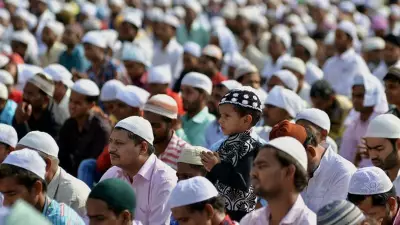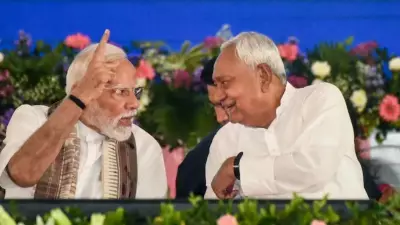
Historic Tenth Inauguration for Bihar's Veteran Leader
In a grand ceremony that marked a significant political milestone, Nitish Kumar was sworn in as the Chief Minister of Bihar for an unprecedented tenth time. The historic event unfolded at Patna's iconic Gandhi Maidan on November 20, 2025, witnessed by top political leaders from across the nation.
The swearing-in ceremony saw 27 ministers taking oath alongside Kumar, though the cabinet has the capacity to expand to 36 members. The political spectacle drew massive attention as it cemented Kumar's position as one of India's most enduring political figures.
Star-Studded Gathering at Gandhi Maidan
The ceremony transformed into a major political event with the presence of Prime Minister Narendra Modi, Union Home Minister Amit Shah, and BJP national president J P Nadda. The gathering was further amplified by chief ministers from 11 NDA-ruled states, including prominent leaders like Uttar Pradesh's Yogi Adityanath and Andhra Pradesh's N Chandrababu Naidu.
Prime Minister Modi capped the ceremony with a memorable gesture, bowing to the audience three times and waving his gamchha, adding a personal touch to the formal proceedings.
Electoral Victory and Political Significance
The NDA's impressive performance in the Bihar assembly polls laid the foundation for this historic swearing-in. The coalition secured 202 seats, making this Nitish Kumar's second-best electoral performance, only surpassed by the 206 seats won during the 2010 polls.
The victory demonstrates Kumar's continued political relevance and the NDA's strong foothold in Bihar politics, despite various challenges and changing political dynamics over the years.
Cabinet Composition and Key Appointments
The newly formed cabinet presents a mix of experienced hands and fresh faces, reflecting both continuity and change in the state's governance approach.
Continuity in Leadership
Senior BJP leaders Samrat Choudhary and Vijay Kumar Choudhary have retained their positions as Deputy Chief Ministers, ensuring stability in the top leadership. The JD(U) has maintained its veteran presence in the cabinet with Bijendra Prasad Yadav, Vijay Kumar Choudhary, and Shravan Kumar continuing their ministerial roles.
Similarly, the BJP has retained its experienced ministers including Mangal Pandey, Pramod Kumar, and Nitin Nabin. BJP state president Dilip Jaiswal has also returned as a minister, maintaining the party's strong representation.
Women Representation and New Faces
The new cabinet features three women ministers, signaling a commitment to gender representation. These include JD(U)'s Dhamdaha MLA Lesi Singh, and BJP's Aurai MLA Rama Nishad and Jamui MLA Shreyasi Singh.
Rama Nishad's appointment is particularly significant as it represents the BJP's outreach to the EBC Mallah community. As the daughter-in-law of late Captain Jaynarayan Nishad, a former union minister, her inclusion carries both political and symbolic weight.
Shreyasi Singh, an accomplished shooter and daughter of late Union minister Digvijay Singh, returns as a second-time MLA from Jamui, bringing youth and achievement to the cabinet.
Notable Political Comebacks and Strategic Appointments
One of the remarkable aspects of the new cabinet is the return of veteran BJP leader Ram Kripal Yadav to political prominence. Despite serving as Union minister earlier, he had maintained a low profile since his 2014 Lok Sabha defeat to Misa Bharati from Pataliputra. His recent victory over RJD strongman Ritlal Yadav from Danapur has revitalized his political career.
Another interesting development is RLM chief Upendra Kushwaha choosing his son Deepak Prakash as a minister from his party. Though Deepak is not currently a legislator, he is expected to receive an MLC position within six months. This move comes despite Kushwaha's wife, Snehlata, being among the four RLM legislators who won the election.
Social Balance and Political Strategy
The cabinet composition demonstrates a careful balancing act in terms of social representation. Of the 27-member cabinet including the Chief Minister, eight belong to the upper caste, five are Dalits, and fourteen represent OBCs and EBCs.
This distribution reflects the NDA's focus on maintaining social equilibrium and catering to various demographic groups that form the backbone of Bihar's political landscape.
Strategic Appointments and Community Outreach
HAM (S) has again chosen Santosh Kumar Suman, son of Union minister Jitan Ram Manjhi, as their ministerial representative. The LJP(R), which secured two cabinet berths, has appointed Sanjay Kumar Singh and Sanjay Kumar.
Sanjay Kumar Singh's victory is particularly noteworthy as he wrested the traditional Mahua seat in Vaishali from the RJD by defeating its nominee Mukesh Kumar Roshan. The contest saw RJD chief Lalu Prasad's son Tej Pratap Yadav finishing third, indicating significant political shifts in the constituency.
Notable Omissions and Future Implications
The cabinet formation also saw some significant omissions, with Nitish Mishra, Jiwesh Mishra, and Sanjay Saraogi not finding places in the new ministry. These exclusions suggest strategic calculations and possibly indicate future political alignments or internal party dynamics.
As Nitish Kumar begins his record tenth term, all eyes will be on how this carefully balanced cabinet addresses Bihar's development challenges and implements the NDA's vision for the state's progress.





